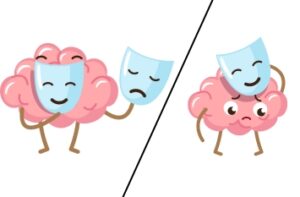
Bipolar Disorder Explained: From Highs to Lows and Everything In Between
Bipolar Disorder Explained: From Highs to Lows and Everything In Between We all experience emotional highs and lows, but for individuals living with bipolar disorder,

Understanding the differences and similarities between tricyclic antidepressants (TCAs) and selective serotonin reuptake inhibitors (SSRIs) is crucial for individuals navigating the complex landscape of antidepressant medications. TCAs and SSRIs are two major classes of antidepressants commonly prescribed to manage depression and other mood disorders.
While both are effective in alleviating symptoms of depression, they differ in their mechanisms of action, side effects, and potential interactions with other medications.
Knowing these distinctions is essential for patients, caregivers, and healthcare providers to make informed decisions about treatment options and to tailor therapy to individual needs.
Tricyclic antidepressants (TCAs) represent one of the earlier classes of antidepressant medications developed to treat depression and other mood disorders. These drugs exert their therapeutic effects by inhibiting the reuptake of neurotransmitters such as serotonin and norepinephrine in the brain, thereby increasing their concentrations in the synaptic cleft and enhancing neurotransmission.
By modulating these neurotransmitter levels, TCAs help regulate mood, alleviate symptoms of depression, and provide relief from certain types of chronic pain.
TCAs work primarily by blocking the reuptake pumps responsible for removing serotonin and norepinephrine from the synaptic space, thereby prolonging the presence of these neurotransmitters. This mechanism leads to enhanced neurotransmission, which is believed to be responsible for the antidepressant effects of TCAs.
Additionally, TCAs may also interact with various other receptors in the brain, contributing to their therapeutic actions and side effects.
TCAs work primarily by blocking the reuptake pumps responsible for removing serotonin and norepinephrine from the synaptic space, thereby prolonging the presence of these neurotransmitters. This mechanism leads to enhanced neurotransmission, which is believed to be responsible for the antidepressant effects of TCAs.
Additionally, TCAs may also interact with various other receptors in the brain, contributing to their therapeutic actions and side effects.
History in Psychiatry:
Tricyclic antidepressants have a rich history in psychiatry, with the first TCA, imipramine, being introduced in the late 1950s. Imipramine was groundbreaking at the time, revolutionizing the treatment of depression and paving the way for the development of subsequent TCAs.
Over the years, TCAs have been widely used to manage various psychiatric conditions, including major depressive disorder, anxiety disorders, obsessive-compulsive disorder (OCD), and certain types of neuropathic pain.
Common TCAs and Brand Names:
Some commonly prescribed tricyclic antidepressants include:
These TCAs are available under various brand names and are often chosen based on factors such as patient tolerance, side effect profile, and specific indications.
Potential Side Effects and Risks:
While effective, TCAs are associated with a range of potential side effects and risks, including:
Additionally, TCAs may pose a risk of overdose, as they have a narrow therapeutic index and can be toxic in excessive doses. Therefore, close monitoring is essential during TCA therapy, especially in individuals with a history of suicidal ideation or cardiac issues.
Indications for Use:
Tricyclic antidepressants are typically prescribed for the following conditions:
Despite the emergence of newer antidepressant classes, TCAs continue to play a significant role in the management of depression and other related conditions, particularly when other treatments have been ineffective or poorly tolerated.
However, due to their side effect profile and potential for drug interactions, TCAs are often reserved for second or third-line use in clinical practice.
Selective serotonin reuptake inhibitors (SSRIs) represent a class of antidepressant medications that are widely prescribed for the treatment of depression and various anxiety disorders, unlike tricyclic antidepressants (TCAs), which affect multiple neurotransmitter systems.
SSRIs specifically target serotonin reuptake, leading to increased levels of serotonin in the synaptic cleft. This mechanism of action is believed to underlie the antidepressant and anxiolytic effects of SSRIs.
SSRIs function by selectively inhibiting the reuptake of serotonin by presynaptic neurons in the brain. By blocking the serotonin transporter protein, SSRIs prevent the reabsorption of serotonin into the presynaptic neuron after it has been released into the synaptic space.
This results in higher concentrations of serotonin being available to bind to postsynaptic receptors, thereby enhancing serotonin neurotransmission.
The development of SSRIs represented a significant advancement in psychiatric treatment, offering a more targeted and selective approach to managing depression and anxiety disorders. The first SSRI, fluoxetine (Prozac), was introduced in the late 1980s and quickly gained popularity due to its efficacy and improved tolerability compared to older antidepressant classes.
Since then, several other SSRIs have been developed, providing patients and clinicians with a broader range of treatment options.
Common SSRIs and Brand Names:
Some commonly prescribed selective serotonin reuptake inhibitors include:
These SSRIs are available under various brand names and are often selected based on factors such as patient preference, tolerability, and specific indications.
Potential Side Effects and Risks:
While generally well-tolerated, SSRIs may cause a range of side effects, including:
Additionally, SSRIs may carry a risk of discontinuation syndrome if abruptly stopped, characterized by flu-like symptoms, dizziness, and mood disturbances. Close monitoring and gradual tapering of SSRIs are recommended to minimize this risk.
Indications for Use:
Selective serotonin reuptake inhibitors are commonly prescribed for the following conditions:
SSRIs are considered first-line treatments for depression and many anxiety disorders due to their favorable side effect profile and efficacy. However, individual responses to SSRIs may vary, and close monitoring is essential to optimize treatment outcomes.
When comparing tricyclic antidepressants (TCAs) and selective serotonin reuptake inhibitors (SSRIs), it’s essential to consider various factors, including their mechanisms of action, side effect profiles, and indications for use. Both classes of antidepressants have distinct characteristics that can influence treatment decisions and patient outcomes.
| Feature | Tricyclic Antidepressants (TCAs) | Selective Serotonin Reuptake Inhibitors (SSRIs) |
| Mechanism of Action | Inhibit reuptake of serotonin and norepinephrine | Selectively inhibit reuptake of serotonin |
| Side Effect Profile | Higher incidence of anticholinergic and cardiovascular side effects | Generally better tolerated with fewer anticholinergic and cardiovascular side effects |
| Indications for Use | Major depressive disorder, anxiety disorders, neuropathic pain | Major depressive disorder, anxiety disorders, obsessive-compulsive disorder, panic disorder |
| Overdose Risk | Higher risk of toxicity and fatal overdose due to narrow therapeutic index | Generally lower risk of overdose and toxicity |
| Drug Interactions | More potential for drug interactions due to effects on multiple receptors | Fewer drug interactions compared to TCAs |
| Feature | Selective Serotonin Reuptake Inhibitors (SSRIs) | Tricyclic Antidepressants (TCAs) |
| Mechanism of Action | Selectively inhibit reuptake of serotonin | Inhibit reuptake of serotonin and norepinephrine |
| Side Effect Profile | Generally better tolerated with fewer anticholinergic and cardiovascular side effects | Higher incidence of anticholinergic and cardiovascular side effects |
| Indications for Use | Major depressive disorder, anxiety disorders, obsessive-compulsive disorder, panic disorder | Major depressive disorder, anxiety disorders, neuropathic pain |
| Overdose Risk | Generally lower risk of overdose and toxicity | Higher risk of toxicity and fatal overdose due to narrow therapeutic index |
| Drug Interactions | Fewer drug interactions compared to TCAs | More potential for drug interactions due to effects on multiple receptors |
| Feature | Selective Serotonin Reuptake Inhibitors (SSRIs) | Monoamine Oxidase Inhibitors (MAOIs) |
| Mechanism of Action | Selectively inhibit reuptake of serotonin | Inhibit the enzyme monoamine oxidase, preventing the breakdown of serotonin, norepinephrine, and dopamine |
| Side Effect Profile | Generally better tolerated with fewer dietary and drug interactions | Require dietary restrictions and can cause hypertensive crisis with certain foods and medications |
| Indications for Use | Major depressive disorder, anxiety disorders, obsessive-compulsive disorder, panic disorder | Major depressive disorder, treatment-resistant depression |
| Overdose Risk | Generally lower risk of overdose and toxicity | Higher risk of hypertensive crisis with overdose, particularly when combined with certain foods or medications |
| Drug Interactions | Fewer drug interactions compared to MAOIs | Require careful monitoring and avoidance of certain medications and foods to prevent hypertensive crisis |
When deciding between tricyclic antidepressants (TCAs) and selective serotonin reuptake inhibitors (SSRIs), several factors come into play to ensure optimal treatment outcomes. Firstly, patient-specific considerations play a crucial role, taking into account factors such as age, medical history, coexisting conditions, and individual response to medication.
For example, older adults may be more susceptible to the anticholinergic effects of TCAs, while individuals with cardiovascular issues may require careful monitoring due to the potential cardiac side effects of both classes of antidepressants. Secondly, assessing tolerance and side effect profiles is essential, as individual tolerances and preferences may significantly influence medication choice.
Some patients may prefer the better tolerability profile of SSRIs, while others may be willing to tolerate the side effects of TCAs if they have not responded to other treatments. Finally, aligning medication choice with the desired therapeutic outcomes and treatment plan is crucial.
Considering whether the primary goal is to alleviate depressive symptoms, manage anxiety disorders, or address coexisting conditions such as chronic pain can help guide the selection between TCAs and SSRIs to meet the patient’s unique needs and preferences.
By carefully weighing these factors, healthcare providers can make informed decisions that optimize the benefits of antidepressant therapy while minimizing potential risks and adverse effects for each individual patient.
Understanding the differences and similarities between tricyclic antidepressants (TCAs) and selective serotonin reuptake inhibitors (SSRIs) is crucial for patients, caregivers, and healthcare providers alike. Both classes of antidepressants offer effective treatment options for depression and other mood disorders, but they vary in their mechanisms of action, side effect profiles, and indications for use.
By considering factors such as patient-specific considerations, tolerance and side effect profiles, and treatment goals, individuals can make informed decisions when choosing between TCAs and SSRIs.

Bipolar Disorder Explained: From Highs to Lows and Everything In Between We all experience emotional highs and lows, but for individuals living with bipolar disorder,

Why Do I Feel High When I’m Not? Get Instant Relief Now! Have you ever experienced that odd sensation of feeling “high” or strangely euphoric,

Tips for Overcoming Depression in College Students Depression is a mental health disorder that affects millions of people worldwide. It can manifest in various forms,
